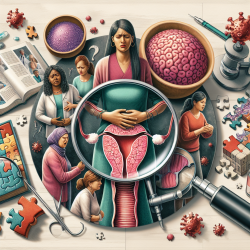Introduction
Endometriosis and chronic pelvic pain (CPP) are conditions that significantly impact the quality of life for many women worldwide. A recent Australian survey has shed light on the similarities and differences in how these conditions affect women, as well as the progress made in reducing the time to diagnosis. This blog will explore the findings of this research and discuss how practitioners can improve their skills and patient outcomes by implementing these insights.
Key Findings from the Research
The study surveyed 409 women, with 340 having a diagnosis of endometriosis and 69 experiencing CPP without a confirmed diagnosis. Both groups reported moderate to severe dysmenorrhea and non-cyclical pelvic pain, significantly affecting their social, academic, and sexual/romantic relationships. The study found a mean diagnostic delay of eight years for endometriosis, although this delay has decreased significantly in recent years.
- Both endometriosis and CPP have substantial negative impacts on various aspects of life.
- There has been a reduction in diagnostic delay and the number of doctors seen before diagnosis in recent years.
- There is an urgent need for improved treatment options and support for women with these conditions.
Implications for Practitioners
Practitioners can enhance their skills and improve patient outcomes by considering the following recommendations based on the research findings:
- Early Recognition: Encourage early recognition of symptoms and reduce normalization of severe menstrual pain, which can lead to delayed diagnosis.
- Comprehensive History Taking: Take a detailed history of pelvic pain symptoms, including the presence of fatigue, which is commonly associated with endometriosis.
- Awareness and Education: Increase awareness among patients and healthcare providers about the symptoms and impact of endometriosis and CPP.
- Interdisciplinary Approach: Implement an interdisciplinary approach to management, involving pain specialists, gynecologists, and mental health professionals to address the multifaceted impact of these conditions.
Encouraging Further Research
While the survey provides valuable insights, there is a need for further research to explore the long-term outcomes of early diagnosis and intervention. Practitioners are encouraged to engage in or support research efforts that aim to develop more effective treatment strategies and improve the quality of life for women with endometriosis and CPP.
Conclusion
The findings from this Australian survey highlight the significant impact of endometriosis and CPP on women's lives and the progress made in reducing diagnostic delays. By implementing the recommendations outlined above, practitioners can improve their skills and contribute to better outcomes for their patients. For those interested in delving deeper into the research, the original paper can be accessed here: Endometriosis and chronic pelvic pain have similar impact on women, but time to diagnosis is decreasing: an Australian survey.










